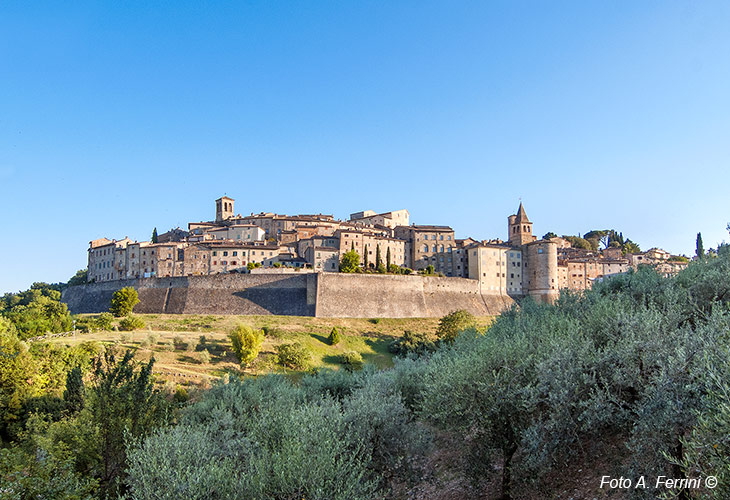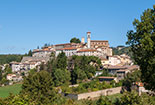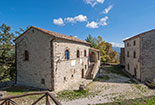ANGHIARI
in Valtiberina, the land of Piero Della Francesca, the first bathed by the Tiber

Texts and photos by Alessandro Ferrini ©
30 accurately described images of Anghiari. Click to enlarge
Anghiari, one of the most beautiful villages in Italy
 Arriving in Valtiberina from the Libbia Pass, this land presents itself with one of the most characteristic and fascinating villages of the entire Arezzo area: Anghiari, a village included among the most beautiful in Italy.
The origins of the place are probably traced back to the Roman age. In the 7th century it was a Lombard settlement. The important and well-known history of Anghiari begins in the early 12th century when the area was donated to the Camaldolese monks with the obligation to build a monastery there. This, named after San Bartolomeo, is to be considered the beginning of the architectural development of the place. This, due to its dominant position over the Tiber valley, was very coveted and in 1175 it was conquered by the Aretine bishops who will immediately start building a castle that will be equipped with a wall whose construction lasted for forty years. The following two centuries saw an alternation of powers over the Castle of Anghiari. This situation ended in 1385 when the area became part of the dominion of the Florentine Republic. The town is also known for the famous Battle of Anghiari on 29 June 1440. In this clash the Florentines defeated the Milanese troops, thus decreeing their supremacy over much of today's Valtiberina Arezzo.
Along the provincial road we are struck by the raised position of the town which seems to be supported by mighty walls. The environment surrounding the village is also beautiful and welcoming, made green by lots of olive trees. Visiting Anghiari means a pleasant walk between the Middle Ages and the Renaissance on the continuous intersection of villages and alleys. Worth seeing are the ancient gates of the village.
Arriving in Valtiberina from the Libbia Pass, this land presents itself with one of the most characteristic and fascinating villages of the entire Arezzo area: Anghiari, a village included among the most beautiful in Italy.
The origins of the place are probably traced back to the Roman age. In the 7th century it was a Lombard settlement. The important and well-known history of Anghiari begins in the early 12th century when the area was donated to the Camaldolese monks with the obligation to build a monastery there. This, named after San Bartolomeo, is to be considered the beginning of the architectural development of the place. This, due to its dominant position over the Tiber valley, was very coveted and in 1175 it was conquered by the Aretine bishops who will immediately start building a castle that will be equipped with a wall whose construction lasted for forty years. The following two centuries saw an alternation of powers over the Castle of Anghiari. This situation ended in 1385 when the area became part of the dominion of the Florentine Republic. The town is also known for the famous Battle of Anghiari on 29 June 1440. In this clash the Florentines defeated the Milanese troops, thus decreeing their supremacy over much of today's Valtiberina Arezzo.
Along the provincial road we are struck by the raised position of the town which seems to be supported by mighty walls. The environment surrounding the village is also beautiful and welcoming, made green by lots of olive trees. Visiting Anghiari means a pleasant walk between the Middle Ages and the Renaissance on the continuous intersection of villages and alleys. Worth seeing are the ancient gates of the village. That of San Martino, or Porta Vecchia, built in the early thirteenth century, the double Porta di Sant’Angelo built in the 13th and 14th centuries, Porta Fiorentina which has the Medici coat of arms on its arch. Some historic buildings contribute to embellish the beautiful architecture of Anghiari. Due to the presence of so many noble coats of arms on the facade, Palazzo Pretorio catches the attention. This was the seat of the Florentine Vicariate from the end of the fourteenth century, in the nineteenth century it became the Town Hall. In the town there are two important museums housed in two other historic buildings: the Museum of the Battle and of Anghiari at Palazzo Marzocco and the State Museum of Palazzo Taglieschi where we find many historical and artistic testimonies of the Valtiberina.
Anghiari is considered the architectural jewel of the upper Valtiberina, the first land bathed by the Tiber. This territory, divided from the Casentino by the Alpe di Catenaia, is very interesting from a landscape point of view. In this respect, the work of man also influenced the construction of the Montedoglio reservoir fed by the Tiber and some of its tributaries located in the geographical triangle delimited by Pieve Santo Stefano, Anghiari and Sansepolcro. The dam formed the largest lake in Tuscany. Valtiberina is also known for its villages rich in important history and architectural forms, as well as high-level figurative art, which span several centuries. In this regard it should be remembered that it is the birthplace of Piero Della Francesca and some works by the Biturgense Master are present in this valley.
That of San Martino, or Porta Vecchia, built in the early thirteenth century, the double Porta di Sant’Angelo built in the 13th and 14th centuries, Porta Fiorentina which has the Medici coat of arms on its arch. Some historic buildings contribute to embellish the beautiful architecture of Anghiari. Due to the presence of so many noble coats of arms on the facade, Palazzo Pretorio catches the attention. This was the seat of the Florentine Vicariate from the end of the fourteenth century, in the nineteenth century it became the Town Hall. In the town there are two important museums housed in two other historic buildings: the Museum of the Battle and of Anghiari at Palazzo Marzocco and the State Museum of Palazzo Taglieschi where we find many historical and artistic testimonies of the Valtiberina.
Anghiari is considered the architectural jewel of the upper Valtiberina, the first land bathed by the Tiber. This territory, divided from the Casentino by the Alpe di Catenaia, is very interesting from a landscape point of view. In this respect, the work of man also influenced the construction of the Montedoglio reservoir fed by the Tiber and some of its tributaries located in the geographical triangle delimited by Pieve Santo Stefano, Anghiari and Sansepolcro. The dam formed the largest lake in Tuscany. Valtiberina is also known for its villages rich in important history and architectural forms, as well as high-level figurative art, which span several centuries. In this regard it should be remembered that it is the birthplace of Piero Della Francesca and some works by the Biturgense Master are present in this valley.








































